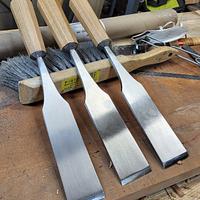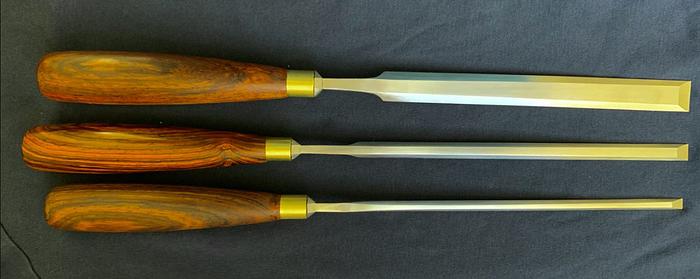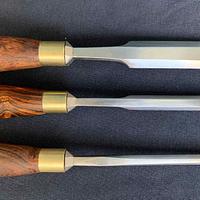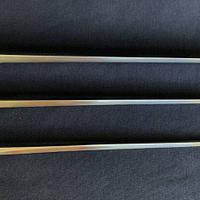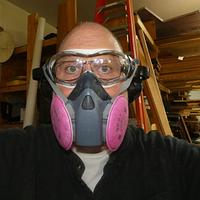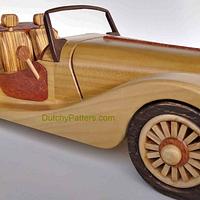Share your craft projects
Make new craft buddies
Ask craft questions
Blog your craft journey
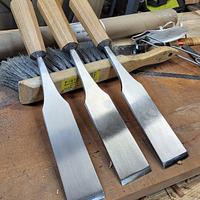
DW_PGH
18 posts
and
1 follower
in over 1 year
in over 1 year
More from DW_PGH
Spicy White Steel Paring Chisels
These are a set of chisels I made for a friend who likes Japanese tools. The steel is a steel called 26c3, which is something you don't see much of commercially because it's a water hardening steel and you have to be able to control warp with it. It is almost identical to white steel #1 from Japan and about as clean/pure, but made by an engineering steel mill in the US. it's very plain, very little alloying, and can be very smooth sharpening and blindingly sharp by feel - as easy to sharpen at 64 hardness (which is what these are) as something like O1 at 61/62 hardness. My samples tested about twice as tough as O1, which means these parers are both harder, but would also take double the bending force to break. Great steel, just not commercially viable because it takes skill to heat treat properly.
They're freehand ground, and the bolsters are mild carbon steel forge welded to the bar. I'd like to forge them all out of a single round of steel, but 26c3 is only available in flats up to 0.25" thick.
Handles are older cocobolo that I got from a clock maker who sold coco from 1970 on ebay. he'd bought it and was afraid to use it until he had a perfect project and aged out / because disabled (if you buy good wood - let it age a little and then use it while you still can!!).
These are differentially hardened, so full hardness up to the shoulder of the tang or a little shy of there, but for durability, the hardness tapers to none or close to none at the bolster - they can be adjusted and will be nearly unbreakable in use. I test my chisels with a 30 oz verawood mallet in rosewood when done, and these are no exception. The should be able to hold an edge like that malleting or paring - all of them.
I put top curvature in these chisels because it's something you can do freehand and it just makes a better chisel. Somewhere in the late 1800s, cutting costs or changing process led to disappearance of a chisels that were stout at the shoulder but had an eccentric curvature so that you get better balance, feel and a bit end that doesn't increase in thickness for quite a while. The side lands taper down with curvature, and also become very small near the edge, but they are not eliminated completely both because zero lands is hard on fingers, but also because it makes for a very brittle corner.
I'm not a professional maker and don't make stuff for sale, but I think it's nice as an amateur to find something you'll make (not the only thing) where you'll try to match or better anything made professionally. it took me a long time to realize that it was worth doing - it involves failing and learning a lot vs. when i started out, i just wanted to buzz through everything.
It takes me about 3 hours each to make these freehand. The metal parts are tapered to thickness at the anvil as much as possible before going to grinding and heat treatment. Grinding is all done freehand at a pair of belt grinders, no grinding jigs and heat treatment is done hand and eye - which simple steels like 26c3 will respond well to if you take the time to learn to get the most out of them. I prefer to forge the chisels all one piece from round and have the taper more radical than this (thicker at the tang), but sometimes you just can't get the steel you want to use in the shape you want to use. I checked with a Voestalpine supplier and they don't have anything thicker - so it's unfortunately not just a "we don't carry it" thing.
They're freehand ground, and the bolsters are mild carbon steel forge welded to the bar. I'd like to forge them all out of a single round of steel, but 26c3 is only available in flats up to 0.25" thick.
Handles are older cocobolo that I got from a clock maker who sold coco from 1970 on ebay. he'd bought it and was afraid to use it until he had a perfect project and aged out / because disabled (if you buy good wood - let it age a little and then use it while you still can!!).
These are differentially hardened, so full hardness up to the shoulder of the tang or a little shy of there, but for durability, the hardness tapers to none or close to none at the bolster - they can be adjusted and will be nearly unbreakable in use. I test my chisels with a 30 oz verawood mallet in rosewood when done, and these are no exception. The should be able to hold an edge like that malleting or paring - all of them.
I put top curvature in these chisels because it's something you can do freehand and it just makes a better chisel. Somewhere in the late 1800s, cutting costs or changing process led to disappearance of a chisels that were stout at the shoulder but had an eccentric curvature so that you get better balance, feel and a bit end that doesn't increase in thickness for quite a while. The side lands taper down with curvature, and also become very small near the edge, but they are not eliminated completely both because zero lands is hard on fingers, but also because it makes for a very brittle corner.
I'm not a professional maker and don't make stuff for sale, but I think it's nice as an amateur to find something you'll make (not the only thing) where you'll try to match or better anything made professionally. it took me a long time to realize that it was worth doing - it involves failing and learning a lot vs. when i started out, i just wanted to buzz through everything.
It takes me about 3 hours each to make these freehand. The metal parts are tapered to thickness at the anvil as much as possible before going to grinding and heat treatment. Grinding is all done freehand at a pair of belt grinders, no grinding jigs and heat treatment is done hand and eye - which simple steels like 26c3 will respond well to if you take the time to learn to get the most out of them. I prefer to forge the chisels all one piece from round and have the taper more radical than this (thicker at the tang), but sometimes you just can't get the steel you want to use in the shape you want to use. I checked with a Voestalpine supplier and they don't have anything thicker - so it's unfortunately not just a "we don't carry it" thing.
14 Comments
for scale, these are around 15" long in total length - there's a reason for that - it's the right length for patternmaking work and especially if you turn the chisel vertical and lean on it - you can have it chest or chin bearing down on it without hunching down.
wow, you may not be a professional but these are sure at a pro level. absolutely beautiful chisels.
working with my hands is a joy,it gives me a sense of fulfillment,somthing so many seek and so few find.-SAM MALOOF.
Great looking chisels, bet they are as great using them as they look. Well done.
Ron
yessir on that, and thanks for the compliments - both of you. The steel gets a series of grain refinement steps before it's hardened and I hardness test each of the chisels before proceeding with grinding. Typical difference in hardness vs. the 64 target is usually 1/2 of a point or less. I ironed out the heat treatment before I ironed out the aesthetics as far as making tools - which I think is the right order to go in. It's time consuming to make something that looks nice - if it can't stand out against production tools in use then spending that time on aesthetic things doesn't seem very sensible.
Beautiful work, those are very nice.
.................. John D....................
Not so often we see peeps making the chisel blanks, yet to have them be some sort of special steel, kinda cool. I love the length, it's what a paring chisel should be about, and they don't have the stubby short handles I often see, Nice build.
Though I can't comment on their performance, they sure look like a million!
Based on your steel working comments though, I can say they are better than a sharp stick 🤠
Fine work as always!
Based on your steel working comments though, I can say they are better than a sharp stick 🤠
Fine work as always!
Amazing work! Well done.
Ryan/// ~sigh~ I blew up another bowl. Moke told me "I made the inside bigger than the outside".
DW
Welcome to Craftisian.
I don't know the first thing about steel. Those are a work of art.
Welcome to Craftisian.
I don't know the first thing about steel. Those are a work of art.
Petey
More than 3 beautys!
Thanks for the nice comments, guys.
Comment on the handle not being stubby short. I wanted to make london pattern handles or something on chisels, something fancy. I always come back to this style as being more comfortable and intuitive. It's a boring style so you have to tart it up with nice wood if you want it to look like something, but they're kind of long to encourage the butt being in the palm of the user or someone in the hand, but no ability to close or pinch fingers and create strain on part of the body where the power doesn't come from using them in the first place.
The steel isn't something common in tools, but it's good -but it's also a case of being the territory for the maker. You can tell it's good without knowing it's good. some of that is me not screwing up what the steelmaker did when shaping and heat treating it, but a lot of it is just starting with a good stock with good characteristics for a chisel. it's a good time to be an amateur maker - options/supplies and information are everywhere.
Comment on the handle not being stubby short. I wanted to make london pattern handles or something on chisels, something fancy. I always come back to this style as being more comfortable and intuitive. It's a boring style so you have to tart it up with nice wood if you want it to look like something, but they're kind of long to encourage the butt being in the palm of the user or someone in the hand, but no ability to close or pinch fingers and create strain on part of the body where the power doesn't come from using them in the first place.
The steel isn't something common in tools, but it's good -but it's also a case of being the territory for the maker. You can tell it's good without knowing it's good. some of that is me not screwing up what the steelmaker did when shaping and heat treating it, but a lot of it is just starting with a good stock with good characteristics for a chisel. it's a good time to be an amateur maker - options/supplies and information are everywhere.
Beautiful chisels!!!! I wonder if they use that steel to make any bowl gouges??
Cheers, Jim ........................ Variety is the spice of life...............Learn something new every day
Imagine a file, and then imagine that the steel is a cleaner version or at least a match for the best files you've ever used. it's that. But what it has nothing of is tolerance for heat, and it's abrasive wear life is similar to something like 1095 or a cast steel plane blade. so for turning, it'd need to be used on a low speed lathe.
it would make a great file, straight razor, knife or chisel, and it makes a very crisp plane iron. it grinds cooler than most of what's around for plane irons, but it definitely wouldn't tolerate high speed turning, just the same as can happen with turning tools made from old files.
it would make a great file, straight razor, knife or chisel, and it makes a very crisp plane iron. it grinds cooler than most of what's around for plane irons, but it definitely wouldn't tolerate high speed turning, just the same as can happen with turning tools made from old files.
Beautiful! Functional is a plus. Or did I get that backwards? Either way, I envy your work. I bought some O1 to make some odd shaped carving tools, but then found them already made. I don't really have any way to do a decent heat treat. I have enough other irons in the fire.
The Other Steven









